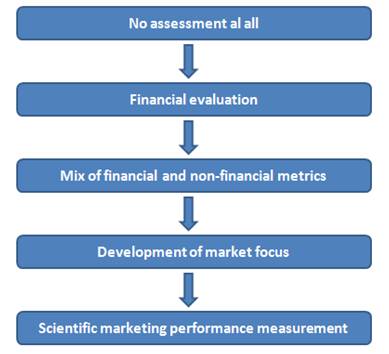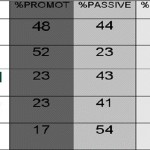Book review: Marketing and the Bottom Line by Professor Tim Ambler – Part 2 of 2
Continuing the review of Professor Tim Ambler’s book, Marketing and the Bottom Line, we now focus on a very interesting topic in the context of marketing performance measurement, in particular and performance measurement, in general, which is the process of performance assessment itself.
Whenever describing a performance measurement or management system, it is of crucial importance to determine the level of maturity of the system, in order to have a clear image on the expectations from the assessment and what can be done to improve the system itself and take it to a next level of complexity.
Professor Tim Ambler identifies five possible stages of marketing performance assessment, as follows (Ambler, 2003):
1. No assessment at all
This characterizes companies in which the idea of marketing performance assessment has not yet even risen, the possible causes being the fact that marketing is not seen as something that needs attention from top management or that things are going so well for the company that there is no place for changes or critical marketing review. However, what these companies neglect is that market conditions may always change impromptu, taking the company by surprise and causing serious damages.
2. Marketing assessment from a financial point of view
In this case, top management is mostly preoccupied with the financial figures, determining that marketing, as well as other functions, is evaluated by means of revenue, profits and, in some cases, brand valuation. The weak point in this context is that financial evaluation lacks the assessment of the sources for cash flow and it only reflects effects, and not causes for that effects.
3. Mix of financial and non-financial metrics
In this stage, management has realized that financial indicators alone are not enough, thus a multitude of non-financial metrics are introduced across the company’s functions, including marketing. Although offering a larger perspective on performance, this situation usually involves the lack of finding a balance for the volume of metrics to be employed. If not treated with caution, measurement can lead to new demands and questions being raised, new metrics being introduced and so on, until the system becomes overwhelming and confusing, the value it adds being limited considering the efforts.
4. Development of a market focus
At this point, the overwhelming variety of metrics (both financial and non-financial) are being streamlined by management, and a collection of indicators are selected in order to give a single coherent view on the market. While projecting a more focused and rationalized approach, the problem in this stage remains the question of whether these metrics are the “right” ones. The author argues that it can happen that marketers hold tight to familiar indicators, which can be a good thing if aiming to maintain comparable data, but also a bad thing if not accurately analyzing the relevance of those metrics for the particular case of the company.
5. Adoption of a scientific approach to measuring performance
This stage involves an even more rationalized and refined process of selecting the performance measures, by applying mathemathic and qualitative analysis to the database of past and current metrics in order to provide the shortest and most relevant list. Where possible, this analysis would reflect which metrics used in the past were best to predict current performance, and although it cannot be guaranteed for sure that they would predict future performance, it would be a good starting point for preparing the pool of the most representative metrics for top management to choose from.
The five stages of marketing performance assessment
Reference
Ambler, T. (2003), Marketing and the Bottom Line. The marketing metrics to pump up cash flow, Second edition, Prentice Hall, London, UK.
Image Source: adapted from Ambler (2003)

Tags: Book review, Marketing and the Bottom Line, Marketing performance, Tim Ambler







